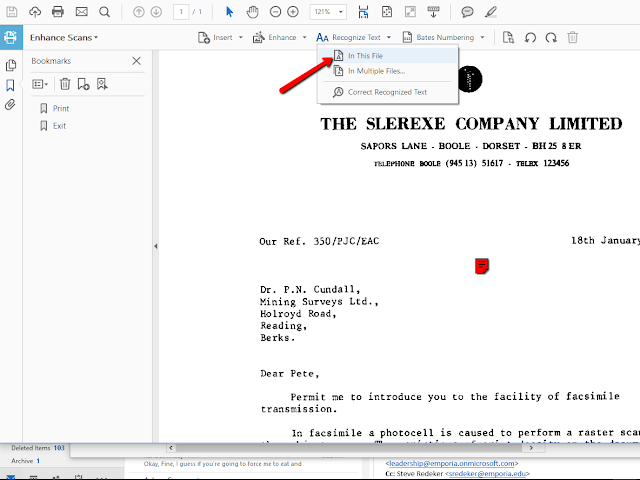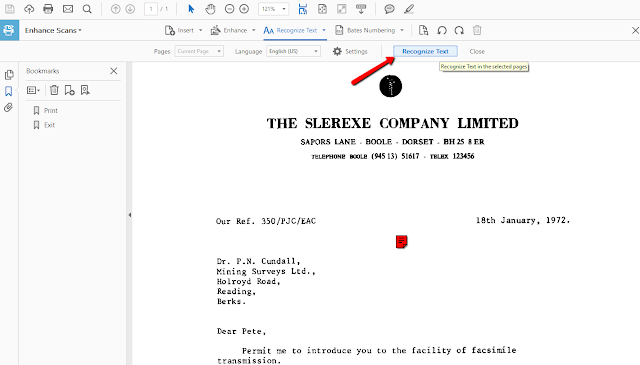Later this summer, ESU Learning Technologies will be converting our plagiarism detection software from Vericite to Simcheck. Actually, Vericite was acquired by Turnitin about a year ago. The product Turnitin developed to replace Vericite is now branded as Simcheck. While it mostly works the same as Vericite, it will have even better features, such as the ability to check for plagiarism scores within discussion forums. To learn more, check out this short integration video. In the meantime, watch our blog and Twitter feed for details regarding the dates for the switch.
Friday, May 31, 2019
Friday, May 24, 2019
Make a PDF Image File Searchable and Selectable

Have you ever encountered a scanned (non-searchable) PDF document and wondered how to make it both searchable and text-selectable? Well, you can actually do that right from inside Acrobat DC. Here's how.
First, we start with a scanned/photocopied PDF, like this example below. Note that this document is essentially an image:

From inside Acrobat DC, select the Tools tab > browse and locate Enhance Scans to add this utility to your Tools menu. Once added, click the Enhance Scans Tool to start the OCR process.

Next, click the Recognize Text tab that appears across the top > In This File sub-option.

Next, click the Recognize Text button that appears below the tabs.

After completing the scan, the document will be in a searchable and text-selectable format that is ready for accessibility tagging!

Friday, May 3, 2019
Which Video Tool Should I Use?
Emporia State supports three instructional video resources for faculty and staff: Kaltura, Zoom, and Panopto. What's the difference between these tools and why are there so many options? Which one is the best option for accessibility?
To answer that question we need to provide a brief product history to understand how we got here. Roughly ten years ago, the Counselor Education on campus program needed a solution to replace an aging VHS recording system. Panopto, a new lecture capture product developed at Carnegie Mellon, provided the perfect solution. It integrated into the campus LMS, supported two camera recording capabilities, could be used in multiple rooms at the same time, and was completely digital. Since then it has been used to record and upload thousands of videos.
About the same time, the campus migrated its webconferencing system from Wimba (later acquired by Blackboard) to Adobe Connect. Webconferencing software had a very narrow niche in the mid 2000s - there was virtually no overlap between a lecture capture product and a webconferencing product.
Fast forward a few years, the campus has since replaced Connect with Zoom and acquired Kaltura. Like Connect and Wimba before it, Zoom is branded as a webconferencing/meeting product. Kaltura, in contrast, is branded/marketed as a video hosting, streaming, and curation product. Again, little or no overlap among products a few years ago, but that's changing.
Each of these products, which are still very viable and highly ranked in Gartner's Magic Quadrant, are now vying to expand their reach and become a one-stop solution for lecture capture, desktop recording, curation, and more. However, shifting a campus that is deeply entrenched in each product to a single solution is easier said than done. Hence, we're likely going to continue licensing these products indefinitely. Let's break these down and see which product is best to use for your purposes:
The primary application of Zoom is live meetings. The campus supports approximately 600 Zoom meetings every month during the semester. However, Zoom can be used for much more:
- Live meetings - Best Use ✓
- Support for 100 simultaneous participants
- Live webcasting ✓
- Support for up to 1000 simultaneous participants
- Two-way communication limited to chat
- Screen capture/recording ✓
- Lecture capture ✓
- External video upload ✘
- Cameras
- Single ✓
- Dual ✘
- Desktop and mobile app ✓
- Accessibility ✓
- Automatic captions ✘ (forthcoming)
- Automatic transcripts ✓
- Cross product integration
- Panopto (Possible, but not currently supported at ESU) ✘
- Kaltura ✓
- Canvas (Limited) ✓
The primary application of Panopto is lecture capture. The campus supports approximately 200 lecture captures every month during the semester. Like Zoom, Panopto can be used for much more:
- Live meetings ✘
- Live webcasting ✓
- Support for up to 10,000 simultaneous participants
- Two-way communication limited to viewer Notes and Comments
- Screen capture/recording ✓
- Lecture capture - Best Use ✓
- External video upload ✓
- Cameras
- Single ✓
- Dual ✓
- Desktop and mobile app ✓
- Accessibility ✓
- Automatic captions ✓
- Automatic transcripts ✘
- Cross product integration
- Zoom (Possible, but not currently supported at ESU) ✘
- Kaltura ✘
- Canvas (Deep) ✓
- Live meetings ✘
- Live webcasting ✓
- Screen capture/recording ✓
- Using Kaltura Capture desktop app
- Lecture capture ✘
- External video upload - Best Use ✓
- Cameras
- Single ✓
- Dual ✘
- Desktop and mobile app ✓
- Accessibility ✓
- Automatic captions ✓
- Automatic transcripts ✓
- Cross product integration
- Zoom ✓
- Panopto ✘
- Canvas (Deep) ✓
Subscribe to:
Comments (Atom)




